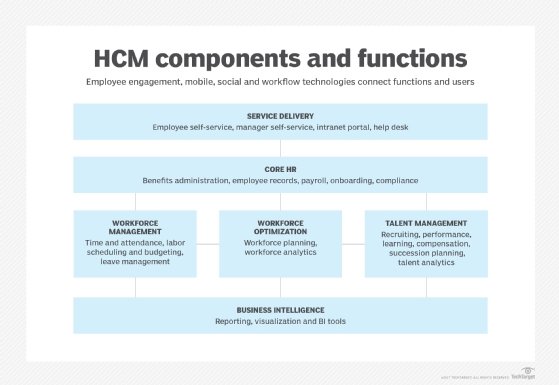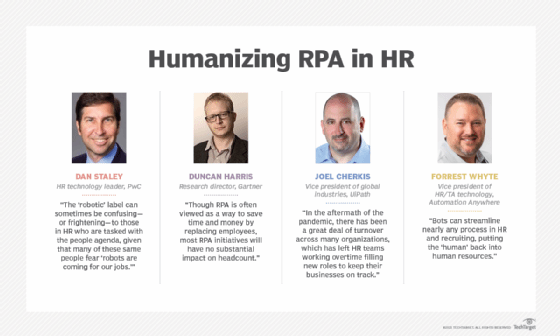What does robotic process automation mean for HR operations?
HR can use RPA to automate manual processes, standardize common tasks, quickly complete existing tasks and free workers from the mundane to spend more time on complex projects.
Robotic process automation can automate many repetitive tasks across the enterprise. For that reason and more, HR departments are turning to RPA because it is easy to implement, improves accuracy and the tools are getting better.
At its core, RPA applications allow business users to create a script, called a bot, which mimics the way humans click and type their way through applications. A classic use case is transferring data from one system to another.
The "robotic" aspect of RPA, however, is often confused with machine learning, according to Duncan Harris, research director, HR technology strategy and management at Gartner. Unless RPA has been augmented with machine learning, it can't exert judgment or make inferences. Still, RPA can play a more significant HR role in automating manual processes, standardizing common tasks, completing existing tasks more quickly through automatic software processes and freeing up employees to complete higher-value and complementary tasks.
Harris recommends that HR leaders start their own internally led RPA program with just one or two robots that could automate enough manual tasks to build upon. "By starting with a few low-complexity and low-risk automations," Harris explained, "HR will have increased capacity to help build more complex solutions as the program matures without having to find additional internal resources."
RPA in HR applications can range from automation to consolidation. Following are eight common use cases:
- automates and sorts resumes according to predefined rules and does follow-ups;
- generates a personalized recruitment offer letter that includes all relevant details;
- creates credentials and configures all IT systems for the onboarding process;
- makes payroll changes, balances accounts and manages the compensation process;
- consolidates all relevant data for the talent review process across systems;
- processes expense reimbursement requests and validates them or flags anomalies;
- automates data entry updates to HR systems and propagates changes across systems; and
- generates reports by consolidating and transforming data across systems.

Putting the human back in HR
RPA use has skyrocketed in HR departments as enterprises struggle with disruptions caused by the COVID-19 pandemic, said Joel Cherkis, vice president of global industries at RPA software provider UiPath. Recruiting and onboarding new employees are among the top HR use cases. "In the aftermath of the pandemic," he explained, "there has been a great deal of turnover across many organizations, which has left HR teams working overtime filling new roles to keep their businesses on track."
Many proponents argue that bots will improve jobs rather than replace them. "Bots can streamline nearly any process in HR and recruiting, putting the 'human' back into human resources," noted Forrest Whyte, vice president of total rewards and HR/TA technology at RPA software provider Automation Anywhere. Yet HR teams need to be aware that RPA can significantly alter company culture and should take a people-first approach when deploying automation.
RPA adoption trends in HR
Two significant factors are driving robotic process automation in human resources, observed Dan Staley, HR technology leader at PwC.
- Many of the leading HCM vendors build RPA and intelligent process automation into their software application processes so HR departments can take advantage of the capabilities in the latest releases.
- Many organizations are upskilling their workforces and procuring RPA tools, teaching them how to use these tools and encouraging them to experiment and share ideas. Organizations and software companies have created sites where their user community or workforce can post and publish bots that automate certain functions in HR. "Even if some of the ideas only save minutes a day," Staley said, "it promotes the usage of these tools and builds the necessary muscle to recognize the larger automation opportunities."
In addition, Whyte found that RPA is graduating from an educational type of project in which HR teams experiment with a few bots to more widespread applications. Since many HR leaders now understand the benefits of automation, he explained, the RPA educational phase in HR is ending. Companies, he explained, are ramping up automation deployments for faster recruiting and onboarding to increase efficiency and improve employee experiences.

Does RPA eliminate HR jobs?
A pervasive concern in human resources is that RPA bots could eliminate many jobs. "The 'robotic' label," Staley said, "can sometimes be confusing -- or frightening -- to those in HR who are tasked with the people agenda, given that many of these same people fear 'robots are coming for our jobs.'"
Many jobs, as well as the human skills needed for those jobs, will change over time but will not be eliminated. The role of HR transaction processor has already been reduced, thanks to various manager and employee self-service capabilities. This trend should continue in HR, Staley said, as RPA reduces the time spent on non-strategic repetitive tasks to focus on more analytical, decision-support activities.
New digital skills will be needed so that HR can understand the power and capabilities associated with RPA technology and continually seek out areas for deployment. Although HR teams will not necessarily have to program an RPA bot, they will need to understand how to harness its power. Transactional steps are reduced in favor of more communication, verification, strategy setting, management and analysis.
Without RPA, for example, a recruiter would have spent most, if not all, of the day sifting through resumes to find the best match, sending emails to candidates, and tracking and reporting to hiring managers the status and rationale for a hiring selection. With automation, the recruiter would instead articulate the hiring procedures to an RPA bot and work with business teams to ensure their hiring needs are programmatically defined. The recruiter could then verify and validate the results. By avoiding the paperwork, the recruiter would have more time to spend building a more diverse candidate pool and personally follow up with the best candidates.
Considerations before implementing RPA for HR processes
"Though RPA is often viewed as a way to save time and money by replacing employees, most RPA initiatives will have no substantial impact on headcount," said Gartner's Harris. However, RPA implementation will require organizations to redesign roles and workflows. Harris believes the adoption of RPA will increase demands for new skills to support higher-value tasks.
HR leaders should consider the most effective ways to enhance digital dexterity and build social-creative skills where RPA is deployed. As frequently performed tasks transition to RPA, managers will face new challenges in measuring employee productivity, maintaining a positive corporate culture and communicating with teams about the benefits and challenges of automation.
When implementing RPA in HR processes, Harris suggested the following considerations:
- More broadly determine the use cases for HCM.
- Create an automation journey across all HCM processes.
- Identify areas where process optimization and automation can reduce handoffs and labor costs, especially in highly repeatable workflows.
- Engage expertise from colleagues outside of HR with business process mapping to learn where RPA is working internally and those who are skilled in RPA implementation.
- Establish a community of practice to continually develop and scale expertise in-house.







